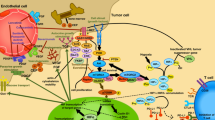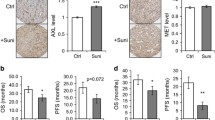Abstract
Purpose
New research findings have revealed a key role for vascular endothelial growth factor (VEGF) in the stimulation of angiogenesis in clear cell renal carcinoma (RCC) which is a highly vascularized and treatment-resistant tumor. Sorafenib (BAY 43-9006, Nexavar®) is a multi-kinase inhibitor which targets receptor tyrosine and serine/threonine kinases involved in tumor progression and tumor angiogenesis. The effect of sorafenib on tumor growth and tumor histology was assessed in both ectopic and orthotopic mouse models of RCC.
Methods
Sorafenib was administered orally to mice bearing subcutaneous (SC, ectopic) or sub-renal capsule (SRC, orthotopic) tumors of murine (Renca) or human (786-O) RCC. Treatment efficacy was determined by measurements of tumor volume and tumor growth delay. In mechanism of action studies, using the 786-O and Renca RCC tumor models, the effect of sorafenib was assessed after dosing for 3 or 5 days in the SC models and 21 days in the SRC models. Inhibition of tumor angiogenesis was assessed by measuring level of CD31 and α-smooth muscle actin (αSMA) staining by immunohistochemistry (IHC). The effect of sorafenib on MAPK signaling, cell cycle progression and cell proliferation was also assessed by IHC by measuring levels of phospho-ERK, phospho-histone H3 and Ki-67 staining, respectively. The extent of tumor apoptosis was measured by terminal deoxynucleotidyl transferase-mediated nick-end labeling (TUNEL) assays. Finally, the effects of sorafenib on tumor hypoxia was assessed in 786-O SC model by injecting mice intravenously with pimonidazole hydrochloride 1 h before tumor collection and tumor sections were stained with a FITC-conjugated Hypoxyprobe antibody.
Results
Sorafenib produced significant tumor growth inhibition (TGI) and a reduction in tumor vasculature of both ectopic and orthotopic Renca and 786-O tumors, at a dose as low as 15 mg/kg when administered daily. Inhibition of tumor vasculature was observed as early as 3 days post-treatment, and this inhibition of angiogenesis correlated with increased level of tumor apoptosis (TUNEL-positive) and central necrosis. Consistent with these results, a significant increase in tumor hypoxia was also observed 3 days post-treatment in 786-O SC model. However, no significant effect of sorafenib on phospho-ERK, phospho-histone H3 or Ki-67 levels in either RCC tumor model was observed.
Conclusion
Our results show the ability of sorafenib to potently inhibit the growth of both ectopically- and orthotopically-implanted Renca and 786-O tumors. The observed tumor growth inhibition and tumor stasis or stabilization correlated strongly with decreased tumor angiogenesis, which was due, at least in part, to inhibition of VEGF and PDGF-mediated endothelial cell and pericyte survival. Finally, sorafenib-mediated inhibition of tumor growth and angiogenesis occurred at concentrations equivalent to those achieved in patients in the clinic.









Similar content being viewed by others
Explore related subjects
Discover the latest articles and news from researchers in related subjects, suggested using machine learning.References
Alavi A, Hood JD, Frausto R, Stupack DG, Cheresh DA (2003) Role of Raf in vascular protection from distinct apoptotic stimuli. Science 301:94–96
Amato RJ (2005) Renal cell carcinoma: review of novel single-agent therapeutics and combination regimens. Ann Oncol 16:7–15
An J, Fisher M, Rettig MB (2005) VHL expression in renal cell carcinoma sensitizes to bortezomib (PS-341) through an NF-kappaB-dependent mechanism. Oncogene 24:1563–1570
Benjamin LE, Hemo I, Keshet E (1998) A plasticity window for blood vessel remodelling is defined by pericyte coverage of the preformed endothelial network and is regulated by PDGF-B and VEGF. Development 125:1591–1598
Benjamin LE, Golijanin D, Itin A, Pode D, Keshet E (1999) Selective ablation of immature blood vessels in established human tumors follows vascular endothelial growth factor withdrawal. J Clin Invest 103:159–165
Bergers G, Song S, Meyer-Morse N, Bergsland E, Hanahan D (2003) Benefits of targeting both pericytes and endothelial cells in the tumor vasculature with kinase inhibitors. J Clin Invest 111:1287–1295
Carlomagno F, Anaganti S, Guida T, Salvatore G, Troncone G, Wilhelm SM, Santoro M (2006) BAY 43–9006 inhibition of oncogenic RET mutants. J Natl Cancer Inst 98:326–334
Clark JW, Eder JP, Ryan D, Lathia C, Lenz HJ (2005) Safety and pharmacokinetics of the dual action Raf kinase and vascular endothelial growth factor receptor inhibitor, BAY 43–9006, in patients with advanced, refractory solid tumors. Clin Cancer Res 11:5472–5480
Coppin C, Porzsolt F, Awa A, Kumpf J, Coldman A, Wilt T (2005) Immunotherapy for advanced renal cell cancer. Cochrane Database Syst Rev:CD001425
Ebbinghaus SW, Gordon MS (2004) Renal cell carcinoma: rationale and development of therapeutic inhibitors of angiogenesis. Hematol Oncol Clin North Am 18:1143–1159, ix–x
Escudier B, Szczylik C, Eisin T, Stadler W, Schwartz B, Shan M, Bukowski R (2005) Randomized phase III trial of the multi-kinase inhibitor sorafenib (BAY 43–9006) in patients with advanced renal cell carcinoma (RCC). Eur. J. Cancer Supplements 3:226
Ferrara N, Kerbel RS (2005) Angiogenesis as a therapeutic target. Nature 438:967–974
Figlin RA (1999) Renal cell carcinoma: management of advanced disease. J Urol 161:381–6; discussion 386–387
Franco M, Man S, Chen L, Emmenegger U, Shaked Y, Cheung AM, Brown AS, Hicklin DJ, Foster FS, Kerbel RS (2006) Targeted anti-vascular endothelial growth factor receptor-2 therapy leads to short-term and long-term impairment of vascular function and increase in tumor hypoxia. Cancer Res 66:3639–3648
Godley PA, Taylor M (2001) Renal cell carcinoma. Curr Opin Oncol 13:199–203
Gore ME, Escudier B (2006) Emerging efficacy endpoints for targeted therapies in advanced renal cell carcinoma. Oncology (Williston Park) 20:19–24
Holash J, Wiegand SJ, Yancopoulos GD (1999) New model of tumor angiogenesis: dynamic balance between vessel regression and growth mediated by angiopoietins and VEGF. Oncogene 18:5356–5362
Hood JD, Bednarski M, Frausto R, Guccione S, Reisfeld RA, Xiang R, Cheresh DA (2002) Tumor regression by targeted gene delivery to the neovasculature. Science 296:2404–2407
Hurwitz H (2004) Integrating the anti-VEGF-A humanized monoclonal antibody bevacizumab with chemotherapy in advanced colorectal cancer. Clin Colorectal Cancer 4(Suppl 2):S62–S68
Hurwitz H, Fehrenbacher L, Novotny W, Cartwright T, Hainsworth J, Heim W, Berlin J, Baron A, Griffing S, Holmgren E, Ferrara N, Fyfe G, Rogers B, Ross R, Kabbinavar F (2004) Bevacizumab plus irinotecan, fluorouracil, and leucovorin for metastatic colorectal cancer. N Engl J Med 350:2335–2342
Jain RK (2003) Molecular regulation of vessel maturation. Nat Med 9:685–693
Jain RK (2005) Normalization of tumor vasculature: an emerging concept in antiangiogenic therapy. Science 307:58–62
Jain RK, Duda DG, Clark JW, Loeffler JS (2006) Lessons from phase III clinical trials on anti-VEGF therapy for cancer. Nat Clin Pract Oncol 3:24–40
Josko J, Mazurek M (2004) Transcription factors having impact on vascular endothelial growth factor (VEGF) gene expression in angiogenesis. Med Sci Monit 10:RA89–RA98
Karasarides M, Chiloeches A, Hayward R, Niculescu-Duvaz D, Scanlon I, Friedlos F, Ogilvie L, Hedley D, Martin J, Marshall CJ, Springer CJ, Marais R (2004) B-RAF is a therapeutic target in melanoma. Oncogene 23:6292–6298
Kim JH, Jung CW, Cho YH, Lee J, Lee SH, Kim HY, Park J, Park JO, Kim K, Kim WS, Park YS, Im YH, Kang WK, Park K (2005) Somatic VHL alteration and its impact on prognosis in patients with clear cell renal cell carcinoma. Oncol Rep 13:859–864
Mancuso A, Sternberg CN (2005) New treatments for metastatic kidney cancer. Can J Urol 12 Suppl 1: 66–70; discussion 105
Motzer RJ, Mazumdar M, Bacik J, Russo P, Berg WJ, Metz EM (2000) Effect of cytokine therapy on survival for patients with advanced renal cell carcinoma. J Clin Oncol 18:1928–1935
Na X, Wu G, Ryan CK, Schoen SR, di’Santagnese PA, Messing EM (2003) Overproduction of vascular endothelial growth factor related to von Hippel-Lindau tumor suppressor gene mutations and hypoxia-inducible factor-1 alpha expression in renal cell carcinomas. J Urol 170:588–592
Salvatore G, De Falco V, Salerno P, Nappi TC, Pepe S, Troncone G, Carlomagno F, Melillo RM, Wilhelm SM, Santoro M (2006) BRAF is a therapeutic target in aggressive thyroid carcinoma. Clin Cancer Res 12:1623–1629
Shaheen PE, Bukowski RM (2005) Emerging drugs for renal cell carcinoma. Expert Opin Emerg Drugs 10:773–795
Sharma A, Trivedi NR, Zimmerman MA, Tuveson DA, Smith CD, Robertson GP (2005) Mutant V599EB-Raf regulates growth and vascular development of malignant melanoma tumors. Cancer Res 65:2412–2421
Shinojima T, Oya M, Takayanagi A, Mizuno R, Shimizu N, Murai M (2006) Renal cancer cells lacking hypoxia inducible factor (HIF)-1{alpha} expression maintain vascular endothelial growth factor expression through HIF-2{alpha}. Carcinogenesis
Turner KJ, Moore JW, Jones A, Taylor CF, Cuthbert-Heavens D, Han C, Leek RD, Gatter KC, Maxwell PH, Ratcliffe PJ, Cranston D, Harris AL (2002) Expression of hypoxia-inducible factors in human renal cancer: relationship to angiogenesis and to the von Hippel-Lindau gene mutation. Cancer Res 62:2957–2961
Wilhelm SM, Carter C, Tang L, Wilkie D, McNabola A, Rong H, Chen C, Zhang X, Vincent P, McHugh M, Cao Y, Shujath J, Gawlak S, Eveleigh D, Rowley B, Liu L, Adnane L, Lynch M, Auclair D, Taylor I, Gedrich R, Voznesensky A, Riedl B, Post LE, Bollag G, Trail PA (2004) BAY 43–9006 exhibits broad spectrum oral antitumor activity and targets the RAF/MEK/ERK pathway and receptor tyrosine kinases involved in tumor progression and angiogenesis. Cancer Res 64:7099–7109
Acknowledgments
We thank our colleagues at Bayer for technical expertise and support.
Author information
Authors and Affiliations
Corresponding author
Additional information
Presented in part at the AACR-NCI-EORTC International Conference on Molecular Targets and Cancer Therapeutics, November 14–18, 2005, Philadelphia, PA, USA.
Rights and permissions
About this article
Cite this article
Chang, Y.S., Adnane, J., Trail, P.A. et al. Sorafenib (BAY 43-9006) inhibits tumor growth and vascularization and induces tumor apoptosis and hypoxia in RCC xenograft models. Cancer Chemother Pharmacol 59, 561–574 (2007). https://doi.org/10.1007/s00280-006-0393-4
Received:
Accepted:
Published:
Issue Date:
DOI: https://doi.org/10.1007/s00280-006-0393-4




